WHAT MAKES A BAD DIAMOND?
HOW TO TELL IF A DIAMOND IS A BAD QUALITY
This post contains affiliate links. If you use these links to buy something I may earn a commission. Thanks! As an Amazon Associate I also earn from qualifying purchases.
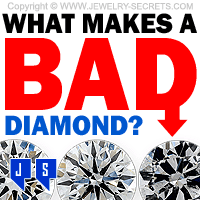
Is that a Bad Diamond?
Is it good?
People always want to know if a stone is a good stone or bad, because no one wants to buy a bad diamond.
EVER!
Right?
Well, honestly, since every diamond is different, unique in nature, and faces up distinctly, there is no exact formula or grade to totally distinguish a good diamond from a bad (even though I’ll try).
One stone with a low clarity could look horrible (dark and spotty), while another diamond may look awesome.
It’s all Subjective!
There is a lot more that goes into the overall beauty and appearance of a diamond than just one grade.
It’s actually about a dozen things (everything listed on a certificate) that comes into play to make a stone desirable, or not.
Because a stone could have a low clarity (again, used just as an example), but have a high color and cut, and that stone could outshine and out sparkle a much high clarity diamond. So beauty really is in the eye of the beholder…
BUT…
There are some guidelines! Some things that you could look for, that will point you in the right direction. Just understand that every diamond needs to be judged separately, with your own eyes (and under a microscope), before you rule it out.
And while it may surprise or shock you, a “bad” diamond normally has nothing to do with carat weight, color, polish, symmetry, shape or even certification…
NOPE!
It’s more likely a factor of hidden things like:
- Bad Make (Good-Fair-Poor Cut)
- Visible Flaws (I Clarity Diamonds)
- Fluorescence (listed on a Diamond Report)
- Enhancements (Laser Drilled, Fracture Filled, Color Enhanced)
Because things like color really is perception, and most people can’t tell one color from another (white, off-white, fine-white — even though I do recommend a whiter diamond).
Polish and symmetry are also almost impossible to detect, too (unless you have a 10x jeweler’s loupe or a special hearts and arrows scope).
The shape is also subjective, since any and all cuts could be admired for their own unique styling and personality.
And Certification doesn’t matter that much either!
Since certification doesn’t make a stone good or bad. Certification only tells you what the stone already is. If the diamond is bad, it doesn’t need the paperwork to prove it!
So let’s dive into these 4 main factors of so-called “bad diamond traits“, and see why these are the things that I strongly say you should watch out for.
1) Bad Make
Personally, I would classify any diamond that has “Good“, “Fair” or “Poor” cut grades as bad. Only because I truly believe that the beauty of a diamond is in its sparkle, and if the stone is just cut okay, or worse (like lumpy or narrow), then it’s not going to shine. And that’s SAD!
I always recommend a cut of at least “Very Good” or “Excellent“. That’s if you want a shiny stone that sparkles like crazy. Otherwise, it’s just going to lack the pizzazz…
2) Visible Flaws
If the diamond is listed as I clarity, which is: I1, I2, or I3, then proceed cautiously. For those diamonds have eye-visible inclusions, meaning you can see them with the bare eye, no loupe needed. And often, these flaws get very large and very noticeable. Like huge black spots, lines, cracks, cloudy areas, it could look like a piece of broken salt!
So Tread Lightly!
Really look at each and every I clarity diamond well. You can find some really nice looking low-clarity stones, but you have to see them with your own eyes to determine if it’s worth the low price tag or not.
3) Fluorescence
Fluorescence is a natural phenomenon that can occur in diamonds due to radiation when the stone was created (billions of years ago). 33% of all diamonds have fluorescence to some degree. This “glowing” effect is usually blue in hue, but it can glow other colors as well, like white or yellow. A UV light (or black light) make it glow, it can look pretty fascinating, and it may not change the look of the diamond either…
But then again… It could!
Fluorescence could make a diamond look hazy, blurry, white, foggy or cloudy, regardless of the color or clarity or cut.
So if a diamond has fluorescence, it’s possible that the stone might face up bad. You’ll have to view the diamond in natural light to see if the stone is affected or not.
4) Enhancements
If the diamond has been tampered with after creation to make it appear better, then I would probably walk away…
For enhancements can weaken a stone, alter the actual grades of the diamond, and it may not even be permanent!
Like Laser Drilled Stones…
Laser drilling is where they drill a hole into a diamond, right down into an unsightly inclusion (like a big black spot), and then they burn or dissolve that flaw out, leaving a huge pit or vacant hole behind. This makes the stone appear better (you don’t see the black spot anymore, and the hole blends in with the stone), but it also leaves a void in the stone which can weaken it. And many times, if a stone has multiple inclusions, you’ll have multiple drill holes which can really weaken the structure and integrity of the stone even more.
Fracture Filling
Fracture filling, takes laser drilling, one step further. Fracture filling is when they actually fill that vacant hole with a foreign clear substance or epoxy to make it blend in much better (harder to detect, even under a microscope). This practice can really improve how a diamond faces up, but you have to be careful, for if you don’t know that the stone was enhanced, and bought it thinking it was a VS diamond…
Then you just got ripped off!
Any laser drilling or fracture filling MUST be disclosed at the time of the sale, meaning, they have to tell you at the time of purchase that it’s been altered. If not, it’s illegal and fraud!
The FTC states that any stone that’s been enhanced needs to be disclosed at the time of purchase (either verbally, or in writing), so you know exactly what it is you’re buying!
Lastly, Color Enhanced Diamonds
Color enhancing is becoming very popular lately, since colored diamonds are everywhere, in every jewelry store and mall. Color enhanced diamonds are stones that are heat treated to improve or change the actual color of the stone. For example, they’ll take an L colored diamond and heat treat it to make the stone whiter. It will then face up like a white diamond and look better and sell better…
The same with blue diamonds, green diamonds, yellow diamonds, pink diamonds… All the colored enhanced diamonds that you see in stores today are enhanced. The color is not real. Which also means, that color may (and probably will) fade over time. The color isn’t permanent and if subjected to heat (like an ultrasonic cleaner or jeweler’s torch), then that fabulous vivid color could dissipate and fade (which sucks if it’s an engagement ring).
This is why I advise to either buy “fancy colored diamonds“, which are TRUE diamonds with TRUE colors (that won’t fade, Mother Nature made them that way), or stick with white diamonds. Stay away from enhanced diamonds, they are just not worth the money.
Let’s look at an example…
And it’s not a great example, since it’s hard to find a diamond that’s been laser drilled online, but I did pick out one that faces up bad. It has a “Good” cut, eye-visible flaws, and fluorescence.
Take a peek…
See how Dark that Stone is?
Now, let’s look at what I would consider a “GOOD” quality of diamond:
- SI1-SI2 Clarity
- G-H Color or Better
- Very Good or Excellent Cut
- Very Good or Excellent Polish
- Very Good or Excellent Symmetry
Like this Diamond Here:
See how that faces up so much better?
That’s GOOD!
And then, of course, we have EXCELLENT
An “Excellent” quality of diamond is higher in almost every aspect. It’s the top of the line.
Excellent quality diamond specifications are:
- VS2 + Clarity
- D-E-F Color
- Excellent Cut
- Excellent Polish
- Excellent Symmetry
Just like this Stone HERE:
Want a Better look?
Compare all three diamonds side by side…
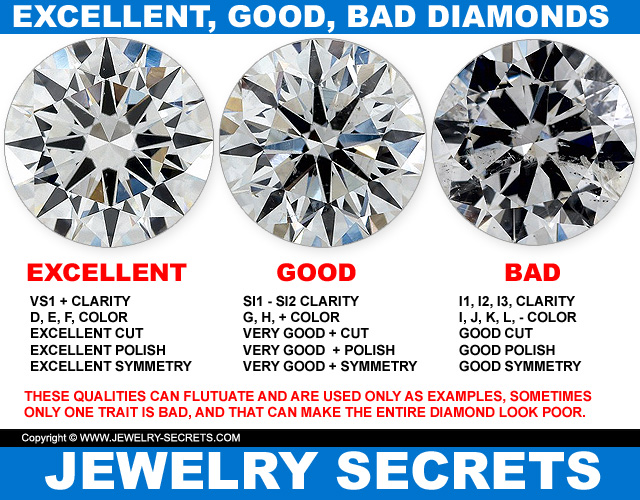
Now you really get the big picture!
Keep in mind that these qualities can be all over the board. These are just my opinions and guidelines… Like I said, a diamond could have tons of bad traits, or just ONE. And it only takes one bad trait to make the entire stone look bad.
Each and every diamond should be viewed, scoped, and analyzed for its strengths and weaknesses, for they are all different, and will all face up different.
And as always, buy GIA diamond reports. They are the best, no ifs, ands, or buts!
And do make sure you check out James Allen, for they have the best diamond prices around!
And that’s GREAT!
Cheers! :)


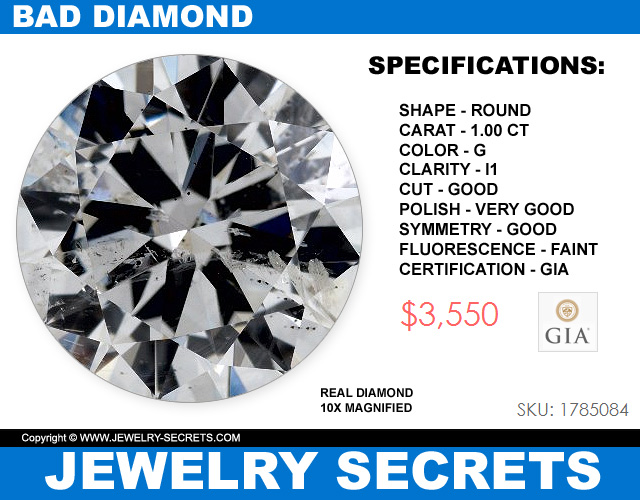
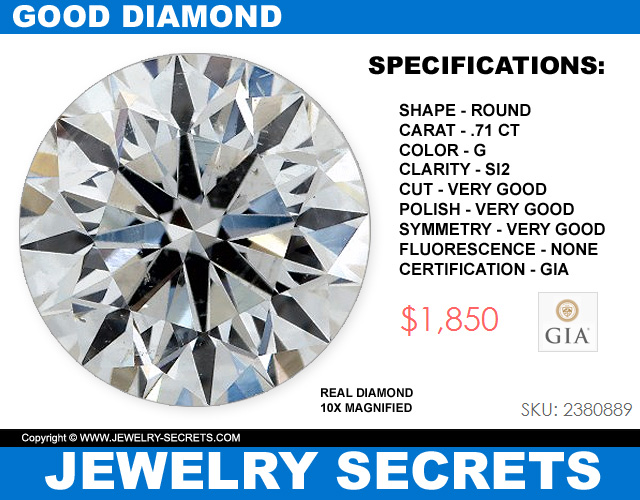
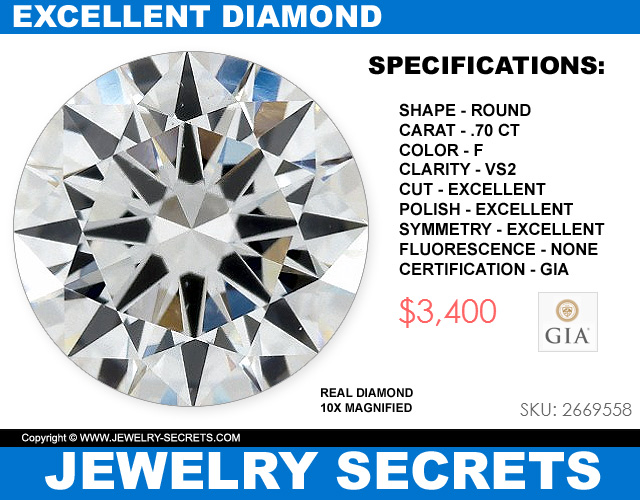












Leave a comment